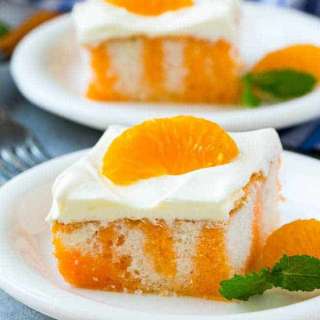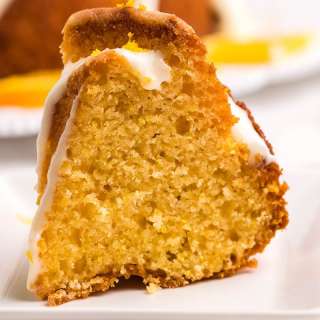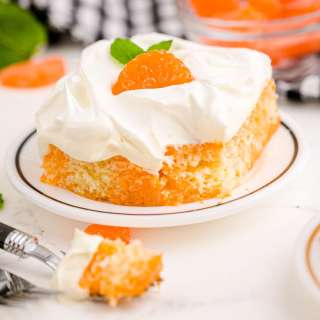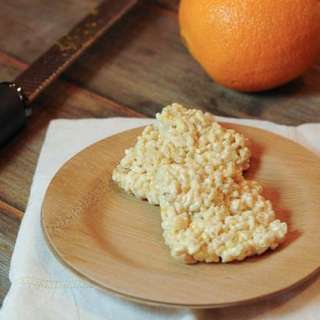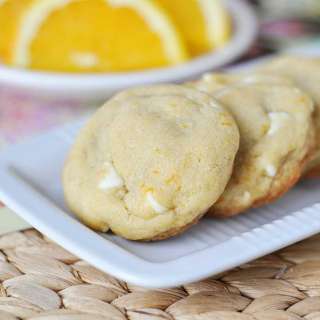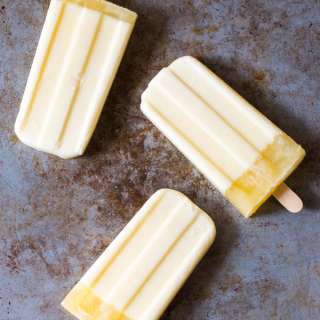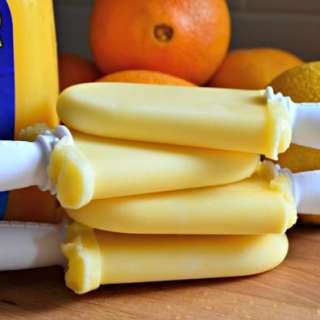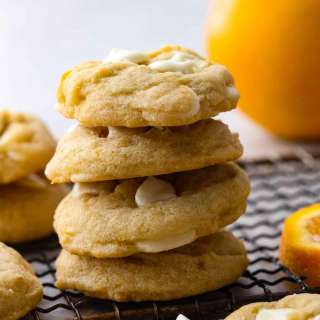
Orange Creamsicle Cake
User Reviews
5.0
279 reviews
Excellent

Orange Creamsicle Cake
Report
This Orange Creamsicle Cake is a moist and flavorful layered cake full of orange and vanilla flavors. It'll remind you of your favorite childhood treat!
Share:
Ingredients
For the Filling:
- 1⅓ cups granulated sugar (266g)
- ¼ cup all-purpose flour (30g)
- 2 tablespoons cornstarch
- 2 cups fresh orange juice strained (from about 3 large oranges/480ml)
- 4 large egg yolks
- ¼ cup cold salted butter cubed (56g)
For the Cake:
- 4½ cups all-purpose flour (540g)
- 1 tablespoon plus 3 teaspoons baking powder
- 2 teaspoons salt
- ⅔ cup salted butter (152g)
- ⅔ cup sour cream (160g)
- 2 tablespoons grated orange zest about 3 large oranges
- 3 cups granulated sugar (600g)
- 6 large eggs
- 2 cups fresh orange juice strained (480ml)
For the Italian Buttercream:
- 3 cups granulated sugar (600g)
- ⅔ cup water (160ml)
- 8 large egg whites
- ¼ teaspoon kosher salt
- 4 cups unsalted butter softened and cut into 1-inch pieces (908g)
- 2 teaspoons pure vanilla extract
- 4 to 6 drops Orange food coloring optional
Instructions
For the Filling:
- In a medium heavy-bottom pot, whisk together the sugar, flour, and cornstarch. Whisk in the orange juice and egg yolks until well combined.
- Set over medium-high heat and cook, stirring constantly with a whisk, until the mixture boils, about 5 minutes
- Continue stirring constantly, until the mixture will become thick and clear, and begins to bubble. Allow mixture to boil for 1 minute.
- Immediately remove from the heat and stir in the cubed butter. Transfer the filling to a bowl. Press plastic wrap directly onto the surface of the filling, and chill until cold, about 2 hours.
For the Cake:
- Position 2 oven racks towards the center fo the oven. Preheat the oven to 350°F. Butter and flour 3 (8-ch) round cake pans or spray with baking spray.
- Sift together the flour, baking powder, and salt into a large bowl.
- In a large mixing bowl or the bowl of a stand mixer fitted with a paddle attachment, beat together the butter, sour cream, and orange zest on medium speed until well combined, about 1 minute.
- With the mixer running, slowly add the sugar. Increase the speed to high and beat until the mixture is light and fluffy, about 2 minutes. Scrape down the sides of the bowl. Add the eggs, one at a time, mixing well and scraping down the sides between additions.
- With the mixer on low speed, add the flour mixture in three additions alternating with the orange juice to the butter mixture. Divide the batter among the prepared cake pans. (I also use cake strips on my pans for more even baking.)
- Bake for 30 minutes until a toothpick inserted in the middle comes out clean, rotating the cake pan positions after 20 minutes. Cool the cakes in the pans for 10 minutes, then loosen the layers by running a knife between the cake and the edge of the pan. Invert the cakes onto a wire cooling and cool completely.
For the Buttercream:
- In a medium saucepan, combine 2⅔ cups sugar and the water. Place over medium-high heat. Stir constantly until sugar melts and becomes clear.
- Bring to a boil. Insert a candy thermometer and boil, without stirring, until the temperature reaches 235°-240°F, about 8 minutes.
- While the syrup boils, combine the egg whites and the remaining 1/3 cup of sugar in a large mixing bowl or the bowl of a stand mixer fitted with the whisk attached. Beat on medium-high speed until soft peaks form.
- When the sugar syrup comes to temperature, carefully drizzle it into the egg whites while the mixer is running on medium speed.
- Once combined, add the salt an increase the speed back to medium-high. Continue beating until the meringue is no longer warm to the touch, about 10 minutes.
- With the mixer running, add the butter into the meringue, one piece at a time. Beat until the butter is combined and the frosting is smooth but stiff enough to spread. Beat in the vanilla.
- If desired, divide the buttercream into a few batches and added varying amounts of food coloring to create an ombre effect. Transfer about 1 cup of the frosting to a piping bag fitted with an 869 or other decorative piping tip and about 1 cup in a piping bag with about ½ inch snipped off the end.
For the Assembly:
- Place one cooled cake layer one a cake stand or plate. Using the frosting in the piping bag without the tip, pipe a single ring around the top edge of the cake creating a frosting barrier. Spread ½ of the Filling over the cake to the frosting barrier. Top with another cake layer. Repeat with more frosting and the remaining filling. Place the remaining cake layer on top.
- Spread the remaining frosting on the outside of the cake in the desired pattern. Using the decorative piping tip, piping frosting on top of the cake. Refrigerate the cake for at least 30 minutes to set the frosting before slicing.
Notes
- If the tops of your orange creamsicle cake layers are domed, use a serrated knife to cut off the top of the domes so you can stack them evenly. Alternatively, use cake strips to help your cake layers come out evenly. Cake strips work by keeping the outside edge of the pan cooler to ensure that the entire cake rises at the same rate, preventing a dome from forming in the middle. If you don’t want to buy cake strips, I have a post on how to DIY cake strips.
- I highly recommend using a scale to measure your flour, as it’s the most accurate method. If you don’t have a scale, fluff your flour with a spoon and spoon it into your cups before leveling it off with a knife. This method prevents you from overpacking the measuring cup.
- Make sure to sift the dry ingredients to remove any lumps. This will help to keep the cake’s crumb soft and light.
- When zesting an orange, stop zesting once you reach the white layer, as the white is bitter.
- You can get more juice from your oranges by bringing them to room temperature and then rolling them on the counter to loosen the insides up.
- To ensure no air bubbles are in the cake batter, gently tap the cake pans on the counter a few times.
- Eggs are easier to separate when cold, but egg whites whip up easier for the frosting when closer to room temperature. I recommend separating them in advance if you have the time. In addition, allowing the egg whites to sit gives them a chance to relax, which improves their elasticity during the whipping process. You also want room temperature eggs when you prepare the cake batter so it incorporates easily without overmixing.
- It is essential to have a clean and dry bowl for whipping the egg whites for the frosting. The egg whites also cannot contain any egg yolk. If the bowl is not completely clean or yolk-free, it prevents your frosting from setting up.
Nutrition Information
Show Details
Calories
1454kcal
(73%)
Carbohydrates
171g
(57%)
Protein
13g
(26%)
Fat
83g
(128%)
Saturated Fat
50g
(250%)
Polyunsaturated Fat
4g
Monounsaturated Fat
22g
Trans Fat
3g
Cholesterol
362mg
(121%)
Sodium
744mg
(31%)
Potassium
339mg
(10%)
Fiber
2g
(8%)
Sugar
130g
(260%)
Vitamin A
2790IU
(56%)
Vitamin C
43mg
(48%)
Calcium
137mg
(14%)
Iron
3mg
(17%)
Nutrition Facts
Serving: 12servings
Amount Per Serving
Calories 1454 kcal
% Daily Value*
| Calories | 1454kcal | 73% |
| Carbohydrates | 171g | 57% |
| Protein | 13g | 26% |
| Fat | 83g | 128% |
| Saturated Fat | 50g | 250% |
| Polyunsaturated Fat | 4g | 24% |
| Monounsaturated Fat | 22g | 110% |
| Trans Fat | 3g | 150% |
| Cholesterol | 362mg | 121% |
| Sodium | 744mg | 31% |
| Potassium | 339mg | 7% |
| Fiber | 2g | 8% |
| Sugar | 130g | 260% |
| Vitamin A | 2790IU | 56% |
| Vitamin C | 43mg | 48% |
| Calcium | 137mg | 14% |
| Iron | 3mg | 17% |
* Percent Daily Values are based on a 2,000 calorie diet.
Genuine Reviews
User Reviews
Overall Rating
5.0
279 reviews
Excellent
Other Recipes
